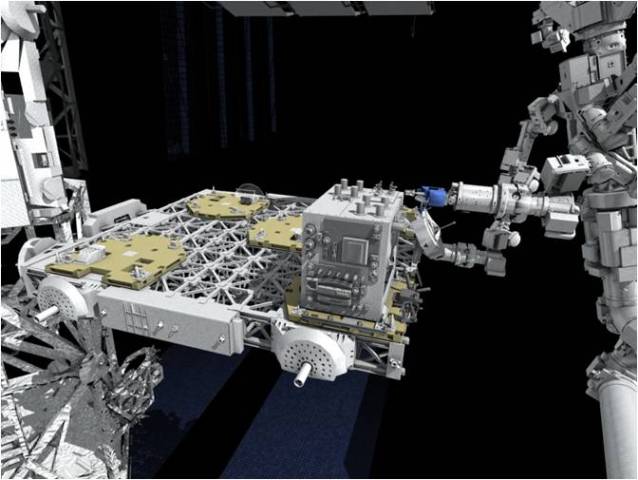NASA is set to launch a robotic gas station into space along with the last space shuttle. If this unique experiment is successful the way satellites are designed will be changed forever. A satellite usually carries all the fuel it will need for its mission on board and as it is finished the life of the satellite is effectively over.
However this new experimental in space refueling project could drastically change this. The Robotic Refueling Mission (RRM) hardware and related equipment is ready to be delivered to the International Space Station on the Atlantis shuttle when it flies out into space on July 8, 2011. The STS-135 flight is going to be NASA’s last shuttle mission to the International Space Station as the 30 year old orbiter program is retired for good.
 Artistic representation shows ISS's Dextre robot (right) performing a robotic refueling task on RRM (center), mounted to ELC4. Image Credit: NASA
Artistic representation shows ISS's Dextre robot (right) performing a robotic refueling task on RRM (center), mounted to ELC4. Image Credit: NASA
The Robotic Refueling Mission experiment was conceived and developed by NASA’s Goddard Space Flight Center in Greenbelt, MD. It will include not just refueling satellites in space but also performing minor repairs on them. The refueling test hardware includes simulated caps, valves, external thermal blankets and ethanol fuel, experiment designers said.
At the space station the Canadian Dextre robot will check the feasibility of the system. It will use its own set of specialized tools to try and access the refueling systems. Unfortunately on most satellites valves and other equipment was never designed to be touched in space. So satellites not only need to be refueled but also modified to allow this refueling process more readily.
RRM is designed to demonstrate that remote-controlled robots can perform refueling tasks in orbit via ground commanding. As the first on-orbit attempt to test robotic refueling techniques for spacecraft not built with on-orbit servicing in mind, RRM is expected to reduce risks and lay the foundation for future robotic servicing missions.
The RRM Tools:
- Wire Cutter and Blanket Manipulation Tool: Cuts through tape securing the thermal blanket and severs safety wires attached to the fuel cap and other gas caps to allow removal.
- Multifunction Tool: Releases, captures and removes the fuel cap and interfaces with a gas panel.
- Safety Cap Removal Tool: Releases, captures and removes the safety cap and a seal.
- Nozzle Tool: Connects to the satellite?s fuel valve using a quick disconnect fitting and is capable of opening and closing the valve. After refueling, the quick disconnect fitting is left behind, giving operators ease of Multifunction Tool access for future refueling.